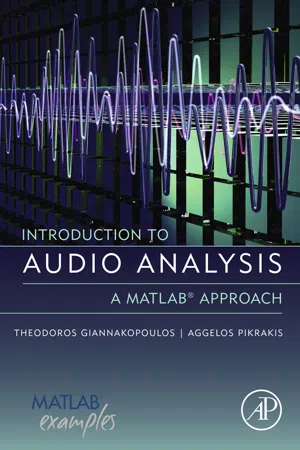
Introduction to Audio Analysis
A MATLAB® Approach
- 288 pages
- English
- ePUB (mobile friendly)
- Available on iOS & Android
About this book
Introduction to Audio Analysis serves as a standalone introduction to audio analysis, providing theoretical background to many state-of-the-art techniques. It covers the essential theory necessary to develop audio engineering applications, but also uses programming techniques, notably MATLAB®, to take a more applied approach to the topic. Basic theory and reproducible experiments are combined to demonstrate theoretical concepts from a practical point of view and provide a solid foundation in the field of audio analysis.Audio feature extraction, audio classification, audio segmentation, and music information retrieval are all addressed in detail, along with material on basic audio processing and frequency domain representations and filtering. Throughout the text, reproducible MATLAB® examples are accompanied by theoretical descriptions, illustrating how concepts and equations can be applied to the development of audio analysis systems and components. A blend of reproducible MATLAB® code and essential theory provides enable the reader to delve into the world of audio signals and develop real-world audio applications in various domains.- Practical approach to signal processing: The first book to focus on audio analysis from a signal processing perspective, demonstrating practical implementation alongside theoretical concepts- Bridge the gap between theory and practice: The authors demonstrate how to apply equations to real-life code examples and resources, giving you the technical skills to develop real-world applications- Library of MATLAB code: The book is accompanied by a well-documented library of MATLAB functions and reproducible experiments
Frequently asked questions
- Essential is ideal for learners and professionals who enjoy exploring a wide range of subjects. Access the Essential Library with 800,000+ trusted titles and best-sellers across business, personal growth, and the humanities. Includes unlimited reading time and Standard Read Aloud voice.
- Complete: Perfect for advanced learners and researchers needing full, unrestricted access. Unlock 1.4M+ books across hundreds of subjects, including academic and specialized titles. The Complete Plan also includes advanced features like Premium Read Aloud and Research Assistant.
Please note we cannot support devices running on iOS 13 and Android 7 or earlier. Learn more about using the app.
Information
Introduction
Abstract
Table of contents
- Cover image
- Title page
- Table of Contents
- Copyright
- Preface
- Acknowledgments
- List of Tables
- List of figures
- 1: Basic Concepts, Representations and Feature Extraction
- 2: Audio Content Characterization
- 3: Other Issues
- Bibliography
- Index